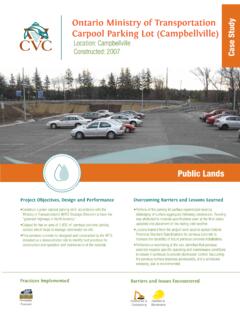Transcription of POSITIVE AND NEGATIVE IMPACTS OF DAMS ON THE …
1 POSITIVE AND NEGATIVE IMPACTS OF DAMS ON THE ENVIRONMENT M. Sait TAHM SC O LU Deputy of the Head of Department, State Hydraulic Works General Directorate, Department of Investigation and Planning, State Hydraulic Works General Directorate 06100 Y cetepe/Ankara. Nermin ANUL Biolog, State Hydraulic Works General Directorate, Department of Investigation and Planning, State Hydraulic Works General Directorate 06100 Y cetepe/Ankara. Fatih EKMEK Environmental Engineer, State Hydraulic Works General Directorate, Department of Investigation and Planning, State Hydraulic Works General Directorate 06100 Y cetepe/Ankara.
2 Nurcan DURMU Environmental Engineer, State Hydraulic Works General Directorate, Department of Investigation and Planning, State Hydraulic Works General Directorate 06100 Y cetepe/Ankara. ABSTRACT The human being has been struggling in order to shape the ecosphere in a man-ner he wants since the first day. The period in which this struggle was observed most intensively was the period covering the transition from a migrant and primitive hunter society to a resident life and farming. The most deep-seated environmental modification against the nature that had been realized in the history of the human being has started at this time.
3 Even the development and downfall of civilizations are correlated to this interaction between the human being and nature. Dams have one of the most important roles in utilizing water resources. They were started to construct long years before gaining present information about hy-drology and hydromechanics. Dams have a great deal of POSITIVE and NEGATIVE effects on the environment be-sides their benefits like controlling stream regimes, consequently preventing floods, obtaining domestic and irrigation water from the stored water and generating en-ergy.
4 Wherever the location of a dam is, its ecological results are the same. The envi-ronmental IMPACTS of dams can be classified according to different criterions as long term and short term IMPACTS , the IMPACTS on the close area and the IMPACTS on the 760 INTERNATIONAL CONGRESS ON RIVER BASIN MANAGEMENT regions where the dam services, social and unsocial IMPACTS , beneficial and harmful IMPACTS .These effects may be ordered in an intensive and complicated manner like climatic, hydraulic, bioligic, social, cultural, archaeological etc.
5 In addition to their very important social and environmental benefits, it is im-portant to minimize the NEGATIVE effects of dams on the environment regarding sus-tainable mentioned effects and their solutions have taken into account in the environmental impact assesment concept. Key Words: Dam, environment, ecology, water resources. INTRODUCTION Dams have one of the most important roles in utilizing water resources. They were constructed long years before gaining present information about hydrology and hydromechanics.
6 They are not ordinary engineering buildings. Dam projects, which are useful in meeting the demand for water in desired times and in regulating stream regimes, have undertaken an important function in the development of civilization. Dams have been constructed in order to prevent floods, to supply drinking and domestic water, to generate energy and for irrigation purposes since the old-times. Dams have a great deal of POSITIVE and NEGATIVE effects on the environment be-sides their benefits like controlling stream regimes, consequently preventing floods, obtaining domestic and irrigation water from the stored water and generating en-ergy.
7 Dams hold possibilities of considerable harm for living beings in addition to their advantages such as meeting basic requirements of the society and increasing living standarts. Nearly 700 dams were built every ten years up to 1950s. This number grew rap-idly after 1950s. While the dams were built and completed it was observed that there was something missing and detrimental. Although the effects of water on human life and the development of civilizations are well-known all over the world, it is claimed that the economical benefits expected from the projects designed to utilize water resources could not be gained and also necesarry precautions to decrease the envi-ronmental, economical and social losses were not taken.
8 Even some studies aiming to block these water supply projects of the developing countries are carried out by some international organizations. Because of this, in the sustainable management of the water, taking into account the economical, social and cultural development and the environmental IMPACTS which came out as a result of the mentioned studies, has gained an increasing importance. Therefore, it is esential that these water resources development studies have a legal background to ensure sustainable development.
9 During these water resources BASIN WATER MANAGEMENT 761 planning studies, the law related to the tasks and authorities of the govermental institutions and establishments, contradicts sometimes with the law directly related with environment. These laws should not be neglected while the planning studies. Naturally current laws always age and change depending on the improvements and technology. The point that should not be overlooked is to make the changes by relying on the scientific , technological and educational studies.
10 The only way to minimize the contradictions between the laws is to make investigations. The investi-gations must be continuous. It is definitly necessary to put the blameless responsibil-ity principle into practice. Plants, animals and people have begun to be damaged from 1960s up today, as a result of uncontrolled extreme population increase, air, water and soil pollution caused by wastes as well as the changes in the ecosystems in parallel. Population increase, technological improvements, the expansions in cities, ways, dams and other engineering studies have disordered the natural balance and the natural body has changed drasticly as a consequence of these activities.









